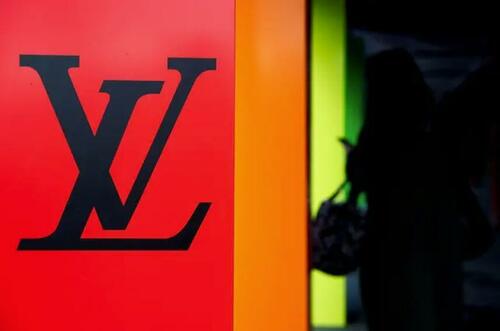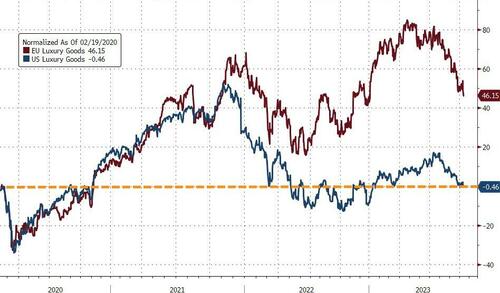
Authored by Jeffrey Tucker via The Epoch Times,
For years now, luxury goods have thrived. It’s not surprising. There has been relative peace, seeming prosperity for the few, and a “Hunger Games” sense of “Let them eat cake” alive in the world. You see it in the lavish and widely advertised events of the Met Gala or the World Economic Forum in Davos. The well-to-do have been living it up with very conspicuous consumption.
This was especially true with zero-percent interest rates, which lasted more or less from 2008 to 2021. This policy was a huge subsidy to the largest businesses and the peddlers of every conceivable absurdity, from crazy theories like DEI and ESG to decadence in goods and services.
Just as it took away the reward for thrift, it was a boon to every extravagance.
It made the cost of borrowed capital essentially free, while punishing savers.
But declining economic fortunes come for everyone in the end, even those who imagine themselves insulated. This week we’ve seen the luxury brand stocks take a heavy hit.
“LVMH Moët Hennessy Louis Vuitton posted sales below analysts’ expectations for the third quarter,” writes the Wall Street Journal, “as the luxury industry grapples with inflation and high interest rates that are squeezing consumer spending.”
“The owner of Louis Vuitton and Dior brands has struggled to lure big-spending Chinese consumers back as Chinese tourism has been slow to pick up again since the pandemic. China was the world’s largest luxury market before Covid-19 hit.”
Indeed, the stock has been utterly slammed, hitting a low for the year after a very long and hugely lucrative run-up.
US luxury goods stocks are basically flat now from the start of COVID (having diverged dramatically since mid 2022 from Europe)...
Not all is well in the world economy, not even in China, and so now we see luxury brands taking it on the chin. Inflation and high interest rates are the culprit. Borrowed capital is finally experiencing a positive cost for the first time in a decade and a half. This has imposed a slow but relentless squeeze on all bank accounts, even the most well-endowed ones.
You have surely encountered these brands in the past. Walking through the best airports, you see jewelers, handbag sellers, and fashion designers with fancy things on sale. You get interested, and then your eye catches the price. It’s astonishing and you almost cannot believe that anyone buys them. But they do. The question is why.
Luxury goods like this have long fascinated economists because they stress the normal laws of demand. Usually with a single good, all other conditions remaining the same, the lower the price, the greater the intensity of demand for the same good. But sometimes, the opposite happens. The higher the price, the more people are convinced of the merit of the purchase.
These are divided between two classes: so-called Veblen goods and Giffen goods.
-
The Veblen good is one that obtains higher demand due to the way in which its status triggers a sense that it should be more valuable.
-
The Giffen good is one in which the price rise itself signals a great broad demand regardless of social status.
French wines might be Veblen goods whereas Bitcoin might be Giffen goods, bought for fear of missing out.
Regardless, both run contrary to conventional wisdom about the relationship between demand and price. I have often wondered why in the world someone would spend $3,000 for a handbag whereas you can obtain something very close to it from eBay for 1/100th the price. The reason has to do with consumer confidence in the product. If even one person asks the question “Where did you get it?” you can answer with confidence and feel great about that.
For some people, that is worth a lot of money.
I’ve felt this way about many wines too. Yes, I can taste the difference between a $12 wine and a $120 wine (I think?) but it doesn’t matter to me. But for some people, sky-high prices signal quality (“You get what you pay for”) and so spending extra comes with great benefits.
But all of this is provided that you can afford it.
We can indulge in all such personal and cultural scrupulosity over brands and status provided that they fit within the family budget. It’s the same on the supply side. When borrowed capital comes at zero price, there seems to be no limit to what is possible.
For years, companies were tempted by the idea that so long as there was some revenue stream, it simply did not matter how leveraged the company could become. So long as there were lenders, there were borrowers. So long as there were consumers, there were companies ready to leverage up.
The dreams of infinite prosperity under a central bank willing to bear the cost forever, if only to keep the financial sector afloat, all seem well. It went on long enough to tempt the entire financial culture to believe it would last forever.
But when times are tough, these luxury goods tend to be the first things to go. You figure out how to be happy with the used handbag from eBay or the lower-priced wine. When the cutting begins, this is the first place you cut.
It was inevitable in these tough economic times—and despite the Biden administration’s pronouncements, these times are increasingly grim—that luxury goods of all types would end up on the chopping block. The stock prices of the luxury brands are a telling predictor of what is to come. If present trends continue, we could see a widespread selloff, together with a closing of high-end retail outlets that have long relied on splurging consumers to provide the cash flow.
We might consider what other luxury goods we as a country consume. A huge welfare state, bases in countries all over the world, bailouts for anyone and everyone, free medical care for anyone in need, and medical experiments on the whole population just to try out fancy new drugs and disease mitigation strategies. This is just for starters. These are the luxuries of prosperity.
It’s time we prepare, and this includes the very rich. The closet full of Louis Vuitton bling doesn’t put food on the table or pay the mortgage. It sure was good while it lasted.
Authored by Jeffrey Tucker via The Epoch Times,
For years now, luxury goods have thrived. It’s not surprising. There has been relative peace, seeming prosperity for the few, and a “Hunger Games” sense of “Let them eat cake” alive in the world. You see it in the lavish and widely advertised events of the Met Gala or the World Economic Forum in Davos. The well-to-do have been living it up with very conspicuous consumption.
This was especially true with zero-percent interest rates, which lasted more or less from 2008 to 2021. This policy was a huge subsidy to the largest businesses and the peddlers of every conceivable absurdity, from crazy theories like DEI and ESG to decadence in goods and services.
Just as it took away the reward for thrift, it was a boon to every extravagance.
It made the cost of borrowed capital essentially free, while punishing savers.
But declining economic fortunes come for everyone in the end, even those who imagine themselves insulated. This week we’ve seen the luxury brand stocks take a heavy hit.
“LVMH Moët Hennessy Louis Vuitton posted sales below analysts’ expectations for the third quarter,” writes the Wall Street Journal, “as the luxury industry grapples with inflation and high interest rates that are squeezing consumer spending.”
“The owner of Louis Vuitton and Dior brands has struggled to lure big-spending Chinese consumers back as Chinese tourism has been slow to pick up again since the pandemic. China was the world’s largest luxury market before Covid-19 hit.”
Indeed, the stock has been utterly slammed, hitting a low for the year after a very long and hugely lucrative run-up.
US luxury goods stocks are basically flat now from the start of COVID (having diverged dramatically since mid 2022 from Europe)…
Not all is well in the world economy, not even in China, and so now we see luxury brands taking it on the chin. Inflation and high interest rates are the culprit. Borrowed capital is finally experiencing a positive cost for the first time in a decade and a half. This has imposed a slow but relentless squeeze on all bank accounts, even the most well-endowed ones.
You have surely encountered these brands in the past. Walking through the best airports, you see jewelers, handbag sellers, and fashion designers with fancy things on sale. You get interested, and then your eye catches the price. It’s astonishing and you almost cannot believe that anyone buys them. But they do. The question is why.
Luxury goods like this have long fascinated economists because they stress the normal laws of demand. Usually with a single good, all other conditions remaining the same, the lower the price, the greater the intensity of demand for the same good. But sometimes, the opposite happens. The higher the price, the more people are convinced of the merit of the purchase.
These are divided between two classes: so-called Veblen goods and Giffen goods.
-
The Veblen good is one that obtains higher demand due to the way in which its status triggers a sense that it should be more valuable.
-
The Giffen good is one in which the price rise itself signals a great broad demand regardless of social status.
French wines might be Veblen goods whereas Bitcoin might be Giffen goods, bought for fear of missing out.
Regardless, both run contrary to conventional wisdom about the relationship between demand and price. I have often wondered why in the world someone would spend $3,000 for a handbag whereas you can obtain something very close to it from eBay for 1/100th the price. The reason has to do with consumer confidence in the product. If even one person asks the question “Where did you get it?” you can answer with confidence and feel great about that.
For some people, that is worth a lot of money.
I’ve felt this way about many wines too. Yes, I can taste the difference between a $12 wine and a $120 wine (I think?) but it doesn’t matter to me. But for some people, sky-high prices signal quality (“You get what you pay for”) and so spending extra comes with great benefits.
But all of this is provided that you can afford it.
We can indulge in all such personal and cultural scrupulosity over brands and status provided that they fit within the family budget. It’s the same on the supply side. When borrowed capital comes at zero price, there seems to be no limit to what is possible.
For years, companies were tempted by the idea that so long as there was some revenue stream, it simply did not matter how leveraged the company could become. So long as there were lenders, there were borrowers. So long as there were consumers, there were companies ready to leverage up.
The dreams of infinite prosperity under a central bank willing to bear the cost forever, if only to keep the financial sector afloat, all seem well. It went on long enough to tempt the entire financial culture to believe it would last forever.
But when times are tough, these luxury goods tend to be the first things to go. You figure out how to be happy with the used handbag from eBay or the lower-priced wine. When the cutting begins, this is the first place you cut.
It was inevitable in these tough economic times—and despite the Biden administration’s pronouncements, these times are increasingly grim—that luxury goods of all types would end up on the chopping block. The stock prices of the luxury brands are a telling predictor of what is to come. If present trends continue, we could see a widespread selloff, together with a closing of high-end retail outlets that have long relied on splurging consumers to provide the cash flow.
We might consider what other luxury goods we as a country consume. A huge welfare state, bases in countries all over the world, bailouts for anyone and everyone, free medical care for anyone in need, and medical experiments on the whole population just to try out fancy new drugs and disease mitigation strategies. This is just for starters. These are the luxuries of prosperity.
It’s time we prepare, and this includes the very rich. The closet full of Louis Vuitton bling doesn’t put food on the table or pay the mortgage. It sure was good while it lasted.
Loading…







